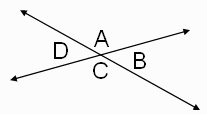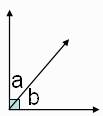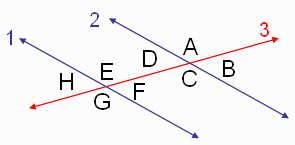
∠B and ∠D are vertical angles.
∠A and ∠B are adjacent angles.
∠A and ∠D are adjacent angles.
∠B and ∠C are adjacent angles.
∠C and ∠D are adjacent angles.

If your child needs math practice, click here.
For sample problems, click here.
Here are some tips for Identifying Angles, which aligns with Texas state standards:
Identifying Angles
Vertical Angles
Vertical angles are formed by two intersecting lines. They are a pair of angles that are across from one another and always have the same degree measurement.
Adjacent Angles
Adjacent angles are a pair of angles that share a side and a vertex but do not overlap.
 |
∠A and ∠C are vertical angles. ∠B and ∠D are vertical angles.
∠A and ∠B are adjacent angles. |
Complementary angles
Complemetary angles are a pair of angles that add up to 90o. Placing complementary angles together forms a right angle.
 |
∠ a and ∠ b are complementary angles. ∠ a and ∠ b are also adjacent angles. |
Supplementary angles
Supplementary angles are a pair of angles that add up to 180o. Placing supplementary angles together forms a straight line.
 |
∠A and ∠B are supplementary angles. ∠A and ∠B are also adjacent angles. |
Corresponding angles
Corresponding angles are formed when a pair of parallel lines is intersected by a third line (also called a transversal line). They are a pair of angles that are at corresponding positions but are not adjacent angles. Corresponding angles are on the same side of the transversal line and always have the same degree measurement.
 |
In this diagram, line 1 and line 2 are parallel lines. Line 3 is the transversal line.
∠A and ∠ E are corresponding angles. |
Copyright Accurate Learning Systems Corporation 2008.
MathScore is a registered trademark.